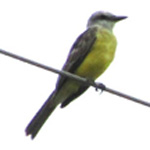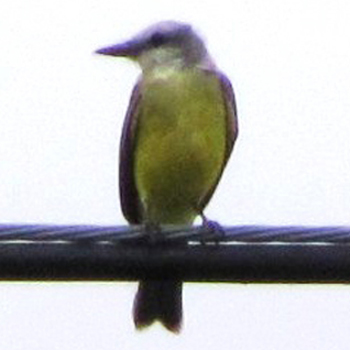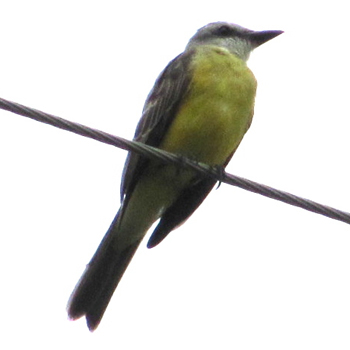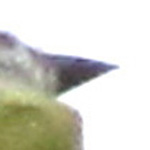On the morning of Monday, September 20,

I was doing some gardening around the photo blind at the HQ before I settled into my paperwork routine for the day. As I put some crucita cuttings in the ground and pulled weeds, I kept hearing a familiar series of call notes in the trees nearby, but I couldn't place the sound. "
Whik-whik, whik, whik-whik-whik!" It was so familiar that I almost passed it up, letting it settle into the dim corners of my aural registration banks. But I had that nagging thought: "I know that sound, but what is that? Where have I heard that before? Is that the sound of a familiar wintering species just now arriving as a first Fall migrant?" The sound seemed out-of-season or out-of-place.
Then, suddenly, the same bird uttered a sharp, raspy, upslurred "breeer!" and a light bulb went on: A Couch's Kingbird--a first Refuge record and a bird unaccustomed to the limestone hills of Central Texas. You may recall that this was one of the subtropical species in the repertoire of that annoying southern-trained mockingbird this Spring at the Beard cabin ("Mocking Who?", May 4). But this was the real deal. It is a species I've seen and heard over the years by the hundreds in South Texas and Mexico but I had only briefly encountered one in the Austin area some 20 years ago. Familiar, but very out of place.
I put down my dandelion digger and raced back to the office to retrieve my binoculars and camera, taking the time to notify colleagues Rob Iski and Jim Mueller of my identification. Conveniently, we returned to find the kingbird perched on a power line in plain view, not far from the HQ building. I took a series of pictures with my trusty point-and-shoot camera, zoomed to the max. My unsteady hand wasn't up to the task, so I invited Rob over to be my human tripod. And a good tripod he was. Below are some of the better images. (I had to adjust the brightness on these images to bring out color and details since that morning provided only a dim cloudy background for photography.)


These pictures show the following field marks of a Couch's Kingbird to distinguish it from our more familiar Western Kingbird: (a) a forked tail rather than a square one, (b) an extensive yellow breast with just some dusky shading on the sides of the upper breast, rather than a gray chest, (c) a dark mask from the base of the bill extending back through the eye, and (d) a long fairly wide black bill. Though not discernible in these pictures, we could see that the tail lacked the white outer webs on the outer tail feathers which a Western Kingbird would show. The most likely species to be confused with Couch's is the nearly identical Tropical Kingbird, an even rarer resident of deep South Texas and the tropics.

Tropical and Couch's can be distinguished by the shape of the bill, with the Tropical having a much narrower bill at the base, and by some very small details of wing feather shapes that are difficult to see in the field. Luckily they are easily distinguished by voice and the sounds I heard were pure Couch's.
* * * * *
Below The Line:
Through the years, we have amassed a nice bird list of some 280+ species. An embarrassingly small number of those were actually first detected by the Refuge's Wildlife Biologist, who you would think might be in a position to pad that list in the course of his (my) regular duties. I take this disparity as a testament to the skills and enthusiasm of our visiting birders and the talented colleagues I have worked with, rather than as some professional short-coming. (I have to. Otherwise it would make me cedar green with envy.) Nonetheless, adding a new bird species to the Refuge list is worth just a little "woo-hoo", isn't it?? Woo-Hoo!!
